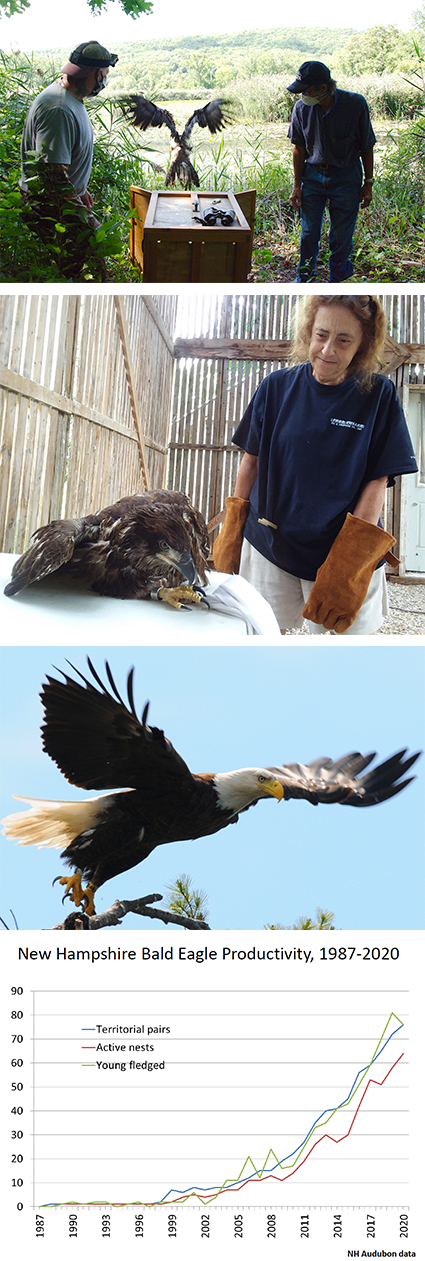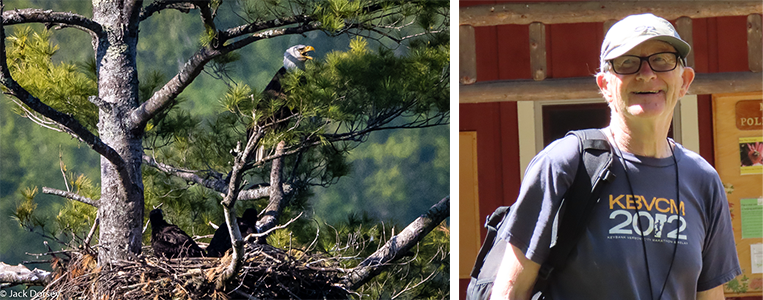Bald Eagle 2020 Breeding Season

Article by Chris Martin
Photos right:
Top: Bill Dean (left) and Bob Harcke (right) release rehabilitated juvenile eagle “Black C/H” near its nest in Hinsdale on 9/3/20. Photo by Chris Martin.
Middle: Wings of the Dawn wildlife rehabilitator Maria Colby checks out a juvenile eagle from Lake Massasecum that came out of its nest during Tropical Storm Isaias in early August. Photo by Chris Martin.
Bottom: Long-time Squam Lake breeding female “Gold WA8” (seen here in 2010) was found dead in Meredith in October 2020 at 21½ years old. Photo by Rick Libbey.
Despite challenges associated with COVID-19, NH Audubon biologists and volunteers confirmed 76 territorial pairs of Bald Eagles in New Hampshire in 2020, up from 72 in 2019. We found 64 pairs incubating and counted 51 successful nests, almost 16% more than last year. A total of 76 young fledged, which although less than 2019’s record high of 81 young, was the second-most ever documented in the state for any year since recovery efforts began in the 1980s. One reason for this slight decline in young fledged in 2020 was that there were no New Hampshire nests that fledged three eaglets, unlike 2019 when a record five nests fledged three young apiece.
One of our broadest measures of breeding success – the ratio of young eagles fledged per territorial pair – was 1.00 young/pair in 2020, right on the state’s long-term productivity average. A grand total of 654 young Bald Eagles have fledged from New Hampshire nests since the species resumed breeding here just over 30 years ago, and over one-third of all the young eagles produced in the state since 1989 have fledged in the past three breeding seasons alone! And we topped 60 incubating pairs and 50 successful pairs for the first time in 2020. Water bodies in the state with multiple eagle breeding pairs are becoming more numerous. Umbagog Lake, home to New Hampshire’s first post-DDT pair in the late 1980s, now has five(!) pairs of breeding eagles (three nests in New Hampshire, two in Maine). Lake Winnipesaukee now has at least seven territorial pairs, Lake Winnisquam has two pairs, and the Great Bay/Little Bay estuary now has three pairs.
Since Fall 2019, we received band encounter reports on 20 individual color-banded Bald Eagles; 16 were seen/photographed alive, and four were found dead. The dead birds were 21, 13, and two 12-yr olds and all were members of long-standing breeding pairs. Two died after encounters with other eagles, one was hit by a vehicle while feeding on roadkill, and one died of an undetermined cause. Most banded birds were encountered in New Hampshire and all were originally banded in New England. The oldest bird was a 23-yr old seen close to its long-time Nubanusit Lake nesting territory, while the youngest was a 3-yr old NH-rehabilitated bird seen in Connecticut.
In 2020, we partnered with Wings of the Dawn Wildlife Rehabilitation Center in Henniker to rescue seven sick/injured juvenile Bald Eagles. All but one of those birds were fitted with a black New Hampshire color band and released back to the wild between late July and early September. Over the past year, we also worked with conservation officers from the US Fish & Wildlife Service, NH Fish & Game, and VT Fish & Wildlife in six additional cases where New Hampshire Bald Eagles were found dead. Two nestlings died in nest collapses, one nestling was electrocuted, and three other immature eagles were found dead.
Since NH Fish & Game removed the Bald Eagle from New Hampshire’s Threatened List in March 2017, our eagle population has continued to double every 5-7 years, pushing the limits of our monitoring resources and state funding. We developed a new five zone protocol in which we are monitoring breeding sites in one zone per year, rotating throughout the entire state over a five year period. The 2020 focal zone was the North Country and next year we will focus on the Connecticut River Valley. Additionally, we continue to document new breeding sites anywhere in the state as they are reported, and add them into future monitoring in the appropriate zones.
We believe this zonal strategy will allow us to detect any significant population changes in a cost effective way. NH Audubon hopes to continue statewide eagle monitoring, but we need to raise additional funds each year to do that. We are grateful for individual donors who helped us raise enough funds to monitor eagles statewide during the 2020 season.
Photo bottom left: Two young eagles await their next feeding at their nest on the north end of Newfound Lake in Hebron, NH. Photo by Jack Dorsey.
Photo bottom right: Congratulations to Jack Dorsey, recipient of NH Audubon’s 2020 John Thalheimer Volunteer Award. Jack is one of the many volunteer eagle observers who contribute much of the data we annually use to help NH Fish & Game manage the state’s eagle population. He has also taken many photos, including this one of the Newfound Bald Eagle nest.
